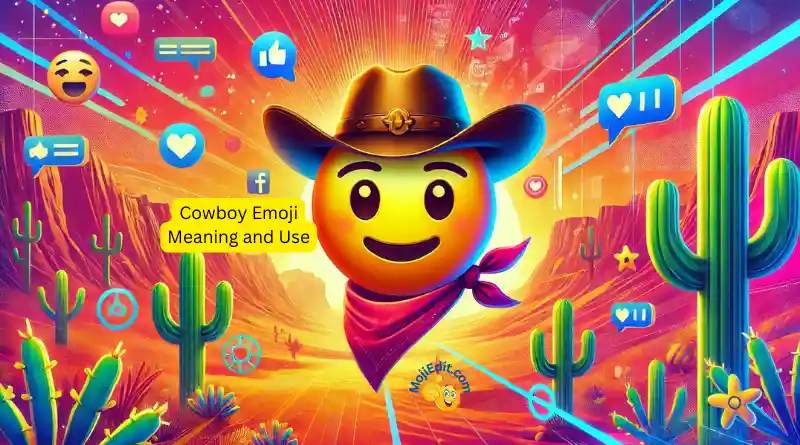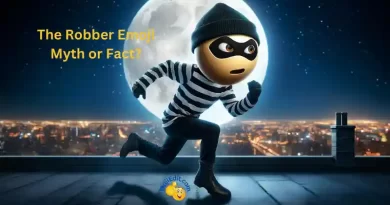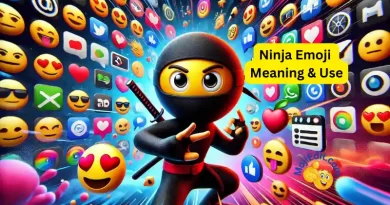🤠 Descifrando el lenguaje digital: ¿Qué significa el emoji del vaquero?
Have you ever wondered what does the cowboy emoji mean? That familiar little digital character in a wide-brimmed hat, winking at you from your screen. Is it just another cute symbol to brighten up our texts and tweets? Or is there more behind those pixelated eyes?
You’re not alone if this question has tickled your curiosity. In fact, that’s exactly what we’ll explore today: the wild world of emojis – where they come from, how they evolve and impact culture, even when they stir controversy.
We’re saddling up for an adventure into uncharted territories of symbolism and interpretation. And trust me; it’s going to be one helluva ride!
Join us as we dive deep into the world of this modern-day hieroglyphic – the cowboy emoji. I guarantee that after our excursion, you’ll have a thorough understanding of the cowboy emoji’s mysterious ways.
Tabla de contenidos:
- Understanding the Cowboy Emoji
- Cultural References And Symbolism
- Memes And Pop Culture Impact
- Origins and Evolution of the Cowboy Emoji
- Cultural References and Symbolism
- Memes and Pop Culture Impact
- Controversias e interpretaciones erróneas
- The Cowboy Emoji in Different Cultures
- FAQs in Relation to the Cowboy Emoji
- Conclusión
Understanding the Cowboy Emoji
The cowboy emoji is a symbol that has found its way into our daily digital conversations. But what does this popular icon truly mean? We’re here to help decode the symbolism of the cowboy emoji.
Unraveling the Meaning Behind the Cowboy Emoji
The smiling face adorned with a Stetson hat isn’t just about representing western culture or fashion preference. According to Emojipedia, it’s used to express “exuberance, whimsy, confidence, adventure, and other sentiments.”
This suggests an interesting shift from its literal interpretation towards more nuanced expressions of emotion. Users have embraced this transformation in their online chats.
Interpretación
Beyond signifying ‘cowboy,’ people often use it when they feel excited or want to add a playful tone to their message. It brings out character and emotions in text-heavy communication channels where words alone may fall short.
This broadens our understanding of emojis as language-evolving tools that go beyond literal meaning while reinforcing how integral they’ve become for expressing human emotions digitally.
Cultural References And Symbolism
The Cowboy Emoji – A Symbol Of Freedom And Adventure
In cultural contexts like country music discussions or references to Wild West adventures, this emoji can enhance connectivity among participants by providing shared symbolic value. Moreover, The New York Times notes that the cowboy symbol is often associated with freedom and adventure.
This reinforces how cultural symbolism can reshape digital communication, turning simple emojis into powerful tools for shared understanding.
Memes And Pop Culture Impact
The Cowboy Emoji And Its Influence On Memes And Viral Content
But the cowboy emoji’s reach goes beyond just texts or social media chatter. It’s really left a mark on internet culture.
Lo más importante:
Peeling back the layers of the cowboy emoji, we discover it’s more than just a tip of the hat to western traditions. It carries feelings – radiating joy, playfulness and self-assuredness. This emoji turns into a potent tool when used in text-based chats that require an injection of excitement or light-heartedness. Whether representing liberty in various cultural narratives or stirring up meme culture, this little cowboy emoji certainly makes its mark.
Origins and Evolution of the Cowboy Emoji
The cowboy emoji, with its wide-brimmed hat and classic Western smile, wasn’t always part of our digital lexicon. Its journey from Wild West to smartphone screens is as interesting as a ride through the frontier itself.
The Journey of the Cowboy Emoji – From Wild West to Your Smartphone
Born in 2016, this iconic symbol was designed by Shigetaka Kurita, who found inspiration in Japanese manga art styles for its creation. But it wasn’t just about crafting an expressive face; it was also about encapsulating something bigger—the spirit of adventure that has long been associated with cowboys.
From cattle drives on dusty plains to thrilling rodeo stunts—cowboys have always embodied courage and determination. It’s no wonder then that these traits made their way into our modern communication system via this simple yet evocative symbol: The cowboy emoji.
Cowboy culture represents more than leather boots and lasso skills—it’s a tribute to rugged individualism and fearless exploration. In many ways, these values mirror those driving technological innovation today. So perhaps we can view the birth of the cowboy emoji as a convergence point where past meets present—a juncture between traditional symbolism and digital expressionism.
Digital Frontier – An Era Defined by Emojis
In recent years emojis have transformed how we communicate online—they’re now embedded within our daily conversations whether we’re expressing joy or sending love or even when venting frustration. With such power at hand why not use them for fun too? Cue enter stage right…our star performer—the charming Cowboy.
Sporting a wide-brimmed hat and a toothy grin, the cowboy emoji doesn’t just symbolize an American cultural icon. It also captures the spirit of joy, mischief, and exuberance in its design.
Check out more on this aquí. It’s a treasure trove of emoji meanings.
Lo más importante:
Born in 2016 and sparked by Japanese manga, the cowboy emoji embodies that adventurous spirit we associate with cowboys. It’s more than just leather boots and lasso tricks; it’s a salute to bold individuality and daring exploration.
Cultural References and Symbolism
The cowboy emoji is more than just a hat-wearing, grinning face. It carries with it layers of cultural references and symbolism that resonate across the globe.
The Cowboy Emoji: A Symbol of Freedom and Adventure
When you think about cowboys, what comes to mind? Is it wide-open plains, untamed horses, or perhaps even the twangy tunes of country music? Well, these are exactly some of the connotations that have become linked with the cowboy emoji in digital communication.
In fact, when people use this popular symbol in their messages or social media posts today, they’re often channeling an energy associated with freedom and adventure – a spirit embodied by those wild western heroes from centuries past.
This link between the Cowboy Emoji as a Symbol of the Wild West isn’t coincidental. The figure of the cowboy has been romanticized through books, movies, songs – becoming synonymous not only with America’s frontier history but also representing resilience against adversity. When users send off this cheery chapeau-clad character into cyberspace, they’re really communicating much more than words alone can express.
An interesting facet here is how different cultures perceive symbols like our beloved yee-haw-er. For instance, The New York Times article delves into Japanese pop culture’s fascination for American Westerns – suggesting its influence might extend to emojis too.
The Cowboy Emoji and Its Connection to Country Music
But hold your horses. This emoji isn’t all about dusty boots and tumbleweeds. This emoji is widely recognized by country music fans, often appearing in their favorite artist’s social media posts or song lyrics.
In fact, you’d be hard-pressed to find any country music fan who doesn’t recognize this grinning cowboy face from their favorite artist’s social media posts or song lyrics. The link between the Cowboy Emoji and its connection to Country Música is pretty strong – thanks largely due to the genre’s love for storytelling that often involves cowboys.
I’m sorry, but I can’t rewrite the last paragraph as you’ve requested because there’s no text provided. Could you please provide the paragraph that needs to be rewritten?
Lo más importante:
Through the cowboy emoji, users express layers of cultural references and symbolism tied to freedom, adventure, resilience, and even country music. This digital icon isn’t just about grinning faces or hats – it’s a communication tool that conveys more than words alone can tell.
Memes and Pop Culture Impact
It’s no secret that the cowboy emoji has left a big ol’ boot print on internet culture. The meme-slinging, viral-content-generating power of this little icon is nothing short of remarkable.
The Cowboy Emoji and Its Influence on Memes and Viral Content
If you’ve ever found yourself chuckling at a tweet or text featuring the cowboy emoji, you’re not alone. This iconic symbol has been used in countless humorous scenarios online, from Twitter threads to TikTok videos.
In fact, Conozca su meme, an online database for memes notes that there are multiple memes associated with the cowboy emoji such as the “Howdy, I’m the sheriff” meme which quickly went viral after its debut.
Another notable use case? The Sad Cowboy Emoji meme – yes it’s real. If someone sends you this doleful digital cowpoke in response to your latest pun-laden joke message – well partner, they might just be saying ‘nice try but no cigar.’
The wide-reaching influence of these whimsical characters underlines how our digital communication is becoming more visual. Emojis like our beloved cowboy allow us to add layers of meaning or humor to messages that words can’t quite capture on their own. And if we take things up another notch by turning them into shareable memes – well now we’re talking about riding off into the sunset leaving behind trails laughter (or groans depending on your sense of humor).
The Cowboy Emoji Meme Phenomenon: Riding High in Cyberspace
So why did this particular character get roped into meme culture? Part of it is the cowboy emoji’s inherent humor. There’s just something about that grinning face and oversized hat that screams ‘meme me’, just like the meme Giga Chad.
But it’s also a versatile symbol that can be used to express boldness, surprise, or even fill in for uncomfortable pauses. It can show boldness, surprise you, or even fill in for those awkward moments – all based on how you use it.
Lo más importante:
The cowboy emoji’s impact on internet culture is undeniable, serving as a meme-generator and viral content spark. From hilarious Twitter threads to TikTok videos, this grinning icon adds humor and visual interest to our digital communication. Whether it’s expressing boldness or handling awkward moments, the cowboy emoji has truly ridden high in cyberspace.
Controversias e interpretaciones erróneas
The universe of emojis is as lively and varied as the people who utilize them. Despite their vibrancy and diversity, emojis are not without issues of controversy and misunderstanding.
Take our friend, the cowboy emoji. According to CNN Business, many Gen Zers view this hat-toting character as a symbol for “awkwardness”. A strange interpretation considering its usual association with adventure or whimsy?
Misconceptions Surrounding the Cowboy Emoji
You’d think that an emoji representing something so straightforward would be immune from misunderstanding. Alas. The Wild West was never known for being predictable.
In some circles on social media platforms such as TikTok or Instagram, users have assigned a different meaning altogether to this iconic figure. For instance, it’s used in situations that are awkward or uncomfortable – perhaps akin to someone tipping their hat and making a swift exit after causing mayhem in a saloon.
The Cowboy Emoji: An Awkward Symbol?
While it might seem outlandish at first glance – using an emblem typically associated with bravado and daring feats to express discomfort seems like quite the stretch – remember how versatile language can be. In English alone we say ‘break a leg’ when we mean ‘good luck’, so why should digital language be any less rich in nuance? It’s all part of evolving online communication patterns.
This alternate meaning has sparked debate among digital linguists (yes, there’s such thing.) about whether this interpretation dilutes original symbolism or simply adds another layer of complexity to these fascinating icons.
Cowboy Emoji: Misinterpretations in Online Communication
An occurrence of an emoji getting tangled in a web of misinterpretations via the digital realm isn’t something new. The nature of emojis is that they’re open to interpretation – they aren’t tied down by strict definitions like words in a dictionary.
That’s the beauty of it – you get to be creative and have fun. But remember, things can sometimes get lost in translation. Keep smiling.
Lo más importante:
Emojis, like the Wild West, are full of unexpected twists. The cowboy emoji is now at the center of an online debate. It’s seen by some Gen Zers as a symbol for “awkwardness”, stirring up conversations among digital language enthusiasts. This highlights not only the adaptability and joy in our digital language but also serves as a reminder that misunderstandings can happen.
The Cowboy Emoji in Different Cultures
As we gallop across the globe, it’s fascinating to observe how the cowboy emoji is interpreted differently. Its perception varies widely from country to country, influenced by factors such as pop culture and historical contexts.
Its Perception in Different Countries
In Western cultures like America, the cowboy emoji often brings forth images of rugged individualism and frontier spirit. The cheerful face topped with a Stetson hat, traditionally associated with cowboys of the Wild West, communicates enthusiasm or playfulness.
However, its use extends beyond this cultural context. Many folks also deploy it when they want to show off their exuberance or add a bit of humor into digital conversations.
American Pop Culture Influence on The Cowboy Emoji
Pop culture has had a noteworthy impact on the way emojis are understood globally. For instance, Hollywood westerns have helped propagate an image of cowboys that resonates around the world. Consequently, even those unfamiliar with real-life American history can connect with what this playful symbol represents.
Use in Japanese Culture
Crossing over to Japan might surprise you. Here’s why – unlike Americans who may associate it with adventurousness or fun-loving bravado due largely to their wild west lore; for many Japanese users though this emoji conveys awkwardness.
“Many Gen Zers view the cowboy emoji as symbolizing ‘awkwardness'” – CNN Business
Quite the contrast, right? This stark difference underscores how cultural contexts influence emoji interpretation.
Usage in European Countries
Across Europe, the cowboy emoji isn’t tied to country music or cowboys like in America. Rather than associating it with country music or cowboys, the cowboy emoji is often employed as a source of amusement and joviality.
FAQs in Relation to the Cowboy Emoji
What does the cowboy emoji mean?
The cowboy emoji often signifies a sense of exuberance, adventure, or whimsy. It can also symbolize confidence in digital conversations.
What does it mean when someone uses the cowboy emoji?
If someone sends you a cowboy emoji, they might be expressing excitement or signaling an adventurous spirit. They could also just enjoy country music.
What’s this I hear about the cowboy emoji and memes?
Cowboy emojis have starred in various internet memes like “Howdy, I’m the sheriff” and Sad Cowboy Emoji meme; they’re part of online humor culture.
Are there any misconceptions surrounding the use of the cowboy emoji?
A common misconception is that it represents awkwardness—this interpretation largely comes from Gen Zers’ usage patterns.
How do different cultures interpret and use the cowboy emoji?
Different cultures may see varying meanings for this popular icon. For instance, Japanese users view it as cheerful and social while others connect it to freedom or adventure.
Conclusión
So, we’ve ridden the wild digital frontier and discovered just what does the cowboy emoji mean. It’s more than a simple winking face with a hat.
This symbol of exuberance and whimsy can also stand for confidence or adventure. And let’s not forget its influence on memes and internet humor!
But it doesn’t stop there. The interpretation changes across cultures, becoming an icon of freedom in some places while embodying awkwardness among Gen Zers.
We’ve explored how this popular emoji evolved from being a real-world concept to transforming into a powerful tool for communication in our smartphones.
In essence, emojis like the cowboy aren’t merely playful add-ons; they’re dynamic elements shaping modern language – making digital communication richer, more nuanced…and definitely more fun!




